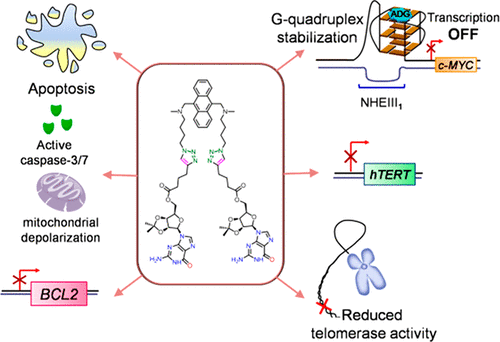当前位置:
X-MOL 学术
›
Bioconjugate Chem.
›
论文详情
Our official English website, www.x-mol.net, welcomes your
feedback! (Note: you will need to create a separate account there.)
G-Quadruplex-Specific Cell-Permeable Guanosine-Anthracene Conjugate Inhibits Telomere Elongation and Induces Apoptosis by Repressing the c-MYC Gene.
Bioconjugate Chemistry ( IF 4.0 ) Pub Date : 2019-11-12 , DOI: 10.1021/acs.bioconjchem.9b00655 Puja Saha 1 , Y Pavan Kumar 1 , Tania Das 1 , Diana Müller 2 , Irene Bessi 2 , Harald Schwalbe 2 , Jyotirmayee Dash 1
Bioconjugate Chemistry ( IF 4.0 ) Pub Date : 2019-11-12 , DOI: 10.1021/acs.bioconjchem.9b00655 Puja Saha 1 , Y Pavan Kumar 1 , Tania Das 1 , Diana Müller 2 , Irene Bessi 2 , Harald Schwalbe 2 , Jyotirmayee Dash 1
Affiliation

|
We herein report a cell-membrane-permeable molecular probe ADG, prepared by conjugating guanosine with anthracene, selectively interacts with c-MYC G-quadruplex over other promoter and telomeric quadruplexes as well as duplex DNA. NMR spectroscopy suggests that ADG interacts with terminal G-quartets as well as with the nearby G-rich tract (G13-G14-G15 and G8-G9-G10) of c-MYC quadruplex. In vitro cellular studies indicate that ADG represses c-MYC expression by stabilizing its promoter G-quadruplex and alters c-MYC-related cellular events. ADG suppresses hTERT and BCL2 gene expressions in a promoter-independent manner, inhibits elongation of telomere length, and activates apoptotic cascades in cancer cells.
中文翻译:

G四联体特异的细胞渗透性鸟苷-蒽结合物通过抑制c-MYC基因抑制端粒伸长并诱导细胞凋亡。
我们在本文中报道了通过将鸟苷与蒽缀合制备的细胞膜可渗透分子探针ADG,其与c-MYC G-四链体在其他启动子和端粒四链体以及双链体DNA上选择性地相互作用。NMR光谱表明,ADG与c-MYC四联体的末端G四联体以及附近的富含G的链(G13-G14-G15和G8-G9-G10)相互作用。体外细胞研究表明,ADG通过稳定其启动子G-四链体并改变c-MYC相关的细胞事件来抑制c-MYC表达。ADG以不依赖启动子的方式抑制hTERT和BCL2基因的表达,抑制端粒长度的延长,并激活癌细胞中的凋亡级联反应。
更新日期:2019-11-13
中文翻译:

G四联体特异的细胞渗透性鸟苷-蒽结合物通过抑制c-MYC基因抑制端粒伸长并诱导细胞凋亡。
我们在本文中报道了通过将鸟苷与蒽缀合制备的细胞膜可渗透分子探针ADG,其与c-MYC G-四链体在其他启动子和端粒四链体以及双链体DNA上选择性地相互作用。NMR光谱表明,ADG与c-MYC四联体的末端G四联体以及附近的富含G的链(G13-G14-G15和G8-G9-G10)相互作用。体外细胞研究表明,ADG通过稳定其启动子G-四链体并改变c-MYC相关的细胞事件来抑制c-MYC表达。ADG以不依赖启动子的方式抑制hTERT和BCL2基因的表达,抑制端粒长度的延长,并激活癌细胞中的凋亡级联反应。











































 京公网安备 11010802027423号
京公网安备 11010802027423号